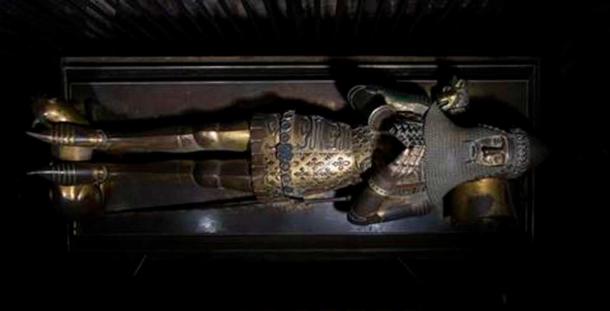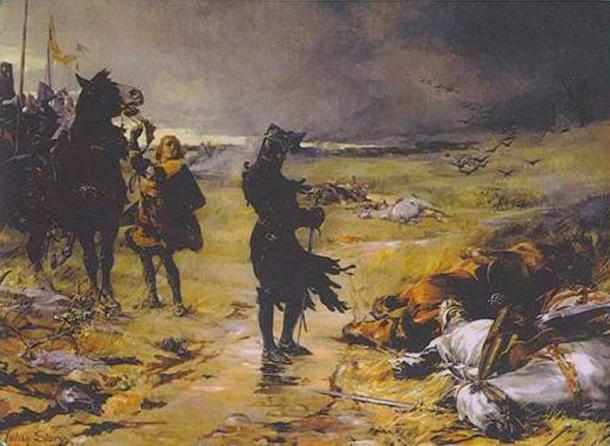
Edward the Black Prince Did Not Die of Chronic Dysentery, Study Reveals
Most historians long ago concluded that Edward of Woodstock, also known as Edward the Black Prince, the heir apparent to the English throne who died at the age of 45 in 1376, fell victim to chronic dysentery. But new research appearing in the journal BMJ Military Health disputes this notion. It is far more likely, the study authors conclude, that the famed Prince whose chance to become king was stolen away by fate actually died from another medical condition.
According to study lead author Dr. James Robert Anderson, a military physician affiliated with the 21st Engineer Regiment of the Claro Barracks in Ripon, England, there are multiple possible causes of the Black Prince’s death. He may have been killed by malaria, brucellosis (a malady caused by consuming unpasteurized dairy products), inflammatory bowel disease (IBD), or even complications caused by a single encounter with dysentery.
Still more research will be needed to determine the exact cause of Edward’s premature death, if it is indeed possible to do that. But for now, it appears the long-standing theory adopted to explain it will have to be abandoned.
- The Strange Story of the Black Prince of Canterbury
- Being Lovesick Was a Real Disease in the Middle Ages

The effigy of the Black Prince on his tomb at Canterbury Cathedral. ( © Dean and Chapter of Canterbury )
The Decline of Prince Edward’s Health and Fortunes
Edward of Woodstock was the oldest son of King Edward III of England, and as such the heir apparent to the English throne. He was given the nickname ‘the Black Prince’ many years after his death, for reasons that remain obscure.
From an early age young Edward displayed an aptitude and a taste for warfare and battle. He participated in his first campaign at age 16, and fought in or led many different wars and skirmishes over the course of his 30-year military career. He fought in both the Hundred Years’ War, in which England was opposed by France, and in a series of conflicts between England and France and Spain that followed the end of that longer conflict. But remarkably, despite being involved in many fierce armed struggles, Edward was never seriously injured on the battlefield.

The Black Prince victorious against the French at the Battle of Crécy (Julian Russell Story / Public Domain)
Yet despite his good luck in this arena, he was still plagued by significant medical problems over the last several years of his life. After being active and vital for so long, Edward’s health suddenly took a turn for the worse in 1367, when he was 37 years old.
“The Black Prince’s illness is thought to have started after his victory at the Battle of Nájera in 1367,” the study authors wrote in their BMJ Military Health article. “He paused in the town of Valladolid, in northern Spain. It was the start of summer and “his army endured sore distress and of hunger, for lack of bread and wine”.”
It seems that Edward the Black Prince was not the only member of the English army inflicted with disease. Accounts from that time suggested that up to 80 percent of the Prince’s army may have succumbed to different diseases, including dysentery.
Chandos Herald’s Life of the Black Prince, a contemporary chronicle of Edward’s deeds, reported that the future king’s illness first developed in France, where he’d traveled after leaving Spain to engage in further conflicts with another of England’s enemies. During the Siege of Limoges (France) in 1370, which saw the British strive to regain a town they’d lost in a previous battle, Edward was confined to his bed and had to be carried on a litter to the scene of the fighting to command his troops.
- To the Shores of Distant Death: The Failed Colony of San Miguel De Gualdape
- How Henry VI Genetically Engineered Henry Tudor for the Throne

The sick Black Prince Edward being carried at the Siege of Limoges (1370) (Public Domain)
What Really Killed the Black Prince? Five Possibilities
The contemporary report crediting the deaths of many of Edward’s soldiers to dysentery appears to explain why historians concluded it killed him, too. But just two years after he was described as being too ill to walk at Limoges, Prince Edward eagerly boarded a ship on its way to Thouars in France, where he would once again lead his army in battle. This is why the authors of the new study don’t believe chronic dysentery claimed the Prince’s life.
“One might question whether he would have been well enough, or even welcomed, aboard a ship in 1372,” they wrote. Chronic dysentery was both a disabling and highly contagious disease, and Edward presumably would have been in no condition to depart to the battlefield if he had been inflicted with this condition for the past five years.
But if he wasn’t suffering from chronic dysentery, what did he have?
The study authors delve into this topic more deeply, discussing numerous options that would fit the symptoms reported over the final nine years of Edward’s life.
The authors propose five possibilities they believe are worth considering: malaria, brucellosis, inflammatory bowel disease (IBD), chronic and severe kidney stones caused by severe dehydration, and complications arising from dysentery (which would not have been chronic but only experienced in a single episode).
In the case of malaria, brucellosis and IBD, all produce fluctuating and chronic symptoms consistent with what the Black Prince allegedly experienced. Such conditions were certainly common in Europe in the Middle Ages, and while all might have been deadly in the long run none would have prevented Edward from surviving for a few years after the initial infection.
With respect to dehydration, that might have been caused by long hours spent in battle in the scorching hot summer weather of Spain. And if Edward actually did have dysentery for a while, but survived it (unlike most of his army), this could have caused kidney damage, anemia, liver abscesses or severe arthritis.
If indeed the Black Prince did fall victim to a disease contracted during warfare, it wouldn’t be an uncommon occurrence.
“Even in modern conflicts and war zones, disease has caused enormous morbidity and loss of life, something that has remained consistent for centuries,” the study authors wrote, before adding that “efforts to protect and treat deployed forces are as important now as in the 1370s.”
A Most Impactful Death
Whatever the cause of the Black Prince’s death, it had serious ramifications that profoundly altered the course of English history.
When King Edward III passed away in 1377, the crown was passed to the king’s second son, the 10-year-old Richard. Despite assuming the throne at a young age King Richard II ruled until 1399, when his cousin Henry Bolingbroke (who Richard had disinherited and disowned) invaded England and overthrew the king. Bolingbroke then named himself king, and that event set off a century of turmoil and unrest that led to the War of the Roses and ultimately to the rise of the Tudors.
How would things have been different if the Black Prince, known as the greatest warrior England had ever produced, had survived long enough to take over the crown? Clearly history would have been changed, and likely dramatically, but whether for better or for worse is impossible to ascertain.
Top image: The effigy of Edward the Black Prince at Canterbury Cathedral. Source: LMBO/Flickr
By Nathan Falde















